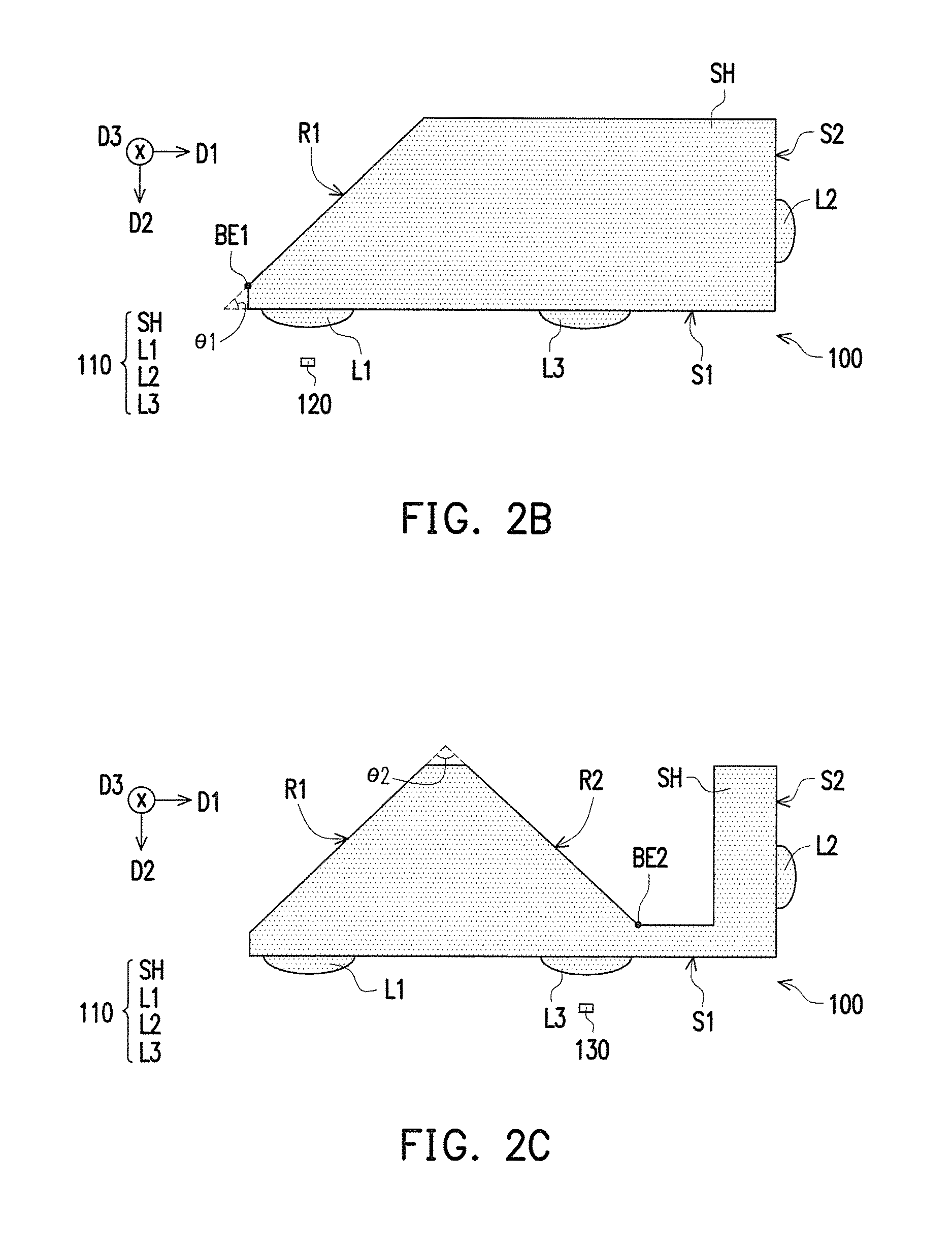Beam-splitting integrated optical element and optical transmitter module
a beam-splitting integrated and optical element technology, applied in the field of beam-splitting integrated optical elements and optical transmitter modules, can solve the problems of reducing the yield rate of the optical transmitter module b, optical power loss, etc., to facilitate the reduction of alignment difficulty and alignment time of the optical transmitter module, and prevent scattering
- Summary
- Abstract
- Description
- Claims
- Application Information
AI Technical Summary
Benefits of technology
Problems solved by technology
Method used
Image
Examples
first embodiment
[0041]FIG. 2A is a schematic top view of an optical transmitter module according to the invention. FIG. 2B and FIG. 2C are respectively schematic cross-sectional views along section lines A-A′ and B-B′ in FIG. 2A. FIG. 2D and FIG. 2E are schematic diagrams of an optical path of the optical transmitter module in FIG. 2A. FIG. 2F and FIG. 2G are respectively schematic diagrams of optical fields OF1 and OF2 in FIG. 2D. FIG. 2H is a schematic diagram of an optical form OF3 in FIG. 2E.
[0042]Referring to FIG. 2A to FIG. 2H, an optical transmitter module 100 includes a beam-splitting integrated optical element 110, at least one first light source 120 and at least one optical detector 130. In this embodiment, the number of each of the first light source 120 and the optical detector 130 is one, but not limited thereto.
[0043]The beam-splitting integrated optical element 110 includes a shell SH, at least one first lens L1, and at least one second lens L2. In this embodiment, the number of each...
second embodiment
[0054]FIG. 3A is a schematic top view of an optical transmitter module according to the invention. FIG. 3B and FIG. 3C are respectively schematic cross-sectional views along section lines A-A′ and B-B′ in FIG. 3A. FIG. 3D and FIG. 3E are schematic diagrams of an optical path of the optical transmitter module in FIG. 3A. Referring to FIG. 3A to FIG. 3E, an optical transmitter module 200 is similar to the optical transmitter module 100, and the same elements are indicated by the same reference numbers, which are not repeated hereinafter.
[0055]A major difference between the optical transmitter module 200 and the optical transmitter module 100 is that, in a beam-splitting integrated optical element 210, a first reflective surface R1 and a second reflective surface R2 of a shell SHA are arranged in the third direction D3 perpendicular to the first optical axis OA1 and the second optical axis OA2. Further, the projection of the first lens L1 is overlapped with the first reflective surface...
third embodiment
[0061]FIG. 4A is a schematic top view of an optical transmitter module according to the invention. FIG. 4B and FIG. 4C are respectively schematic cross-sectional views along section lines A-A′ and B-B′ in FIG. 4A. FIG. 4D and FIG. 4E are schematic diagrams of an optical path of the optical transmitter module in FIG. 4A. Referring to FIG. 4A to FIG. 4E, an optical transmitter module 300 is similar to the optical transmitter module 200, where the same elements are indicated by the same reference numbers, and thus the disposition relation and effectiveness related thereto are not repeated hereinafter.
[0062]A major difference between the optical transmitter module 300 and the optical transmitter module 200 is that, in a beam-splitting integrated optical element 310, a shell SHB has a plane S3 as replacement to the third reflective surface R3. The plane S3 is connected and perpendicular to the first lens surface S1, and the third lens L3 is disposed on the plane S3.
[0063]Referring to FIG...
PUM
 Login to View More
Login to View More Abstract
Description
Claims
Application Information
 Login to View More
Login to View More - R&D
- Intellectual Property
- Life Sciences
- Materials
- Tech Scout
- Unparalleled Data Quality
- Higher Quality Content
- 60% Fewer Hallucinations
Browse by: Latest US Patents, China's latest patents, Technical Efficacy Thesaurus, Application Domain, Technology Topic, Popular Technical Reports.
© 2025 PatSnap. All rights reserved.Legal|Privacy policy|Modern Slavery Act Transparency Statement|Sitemap|About US| Contact US: help@patsnap.com



